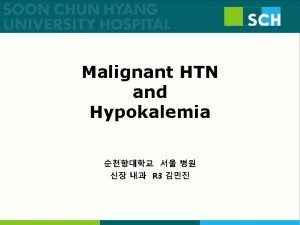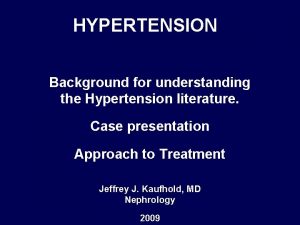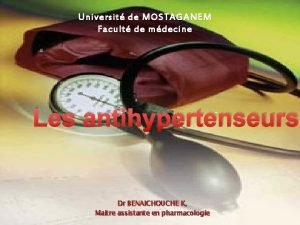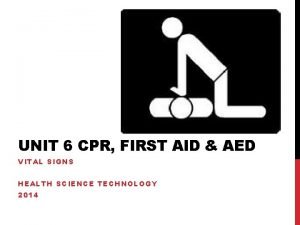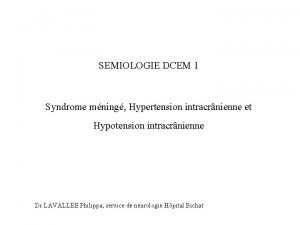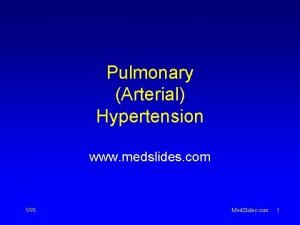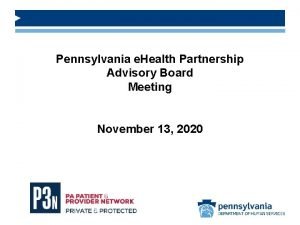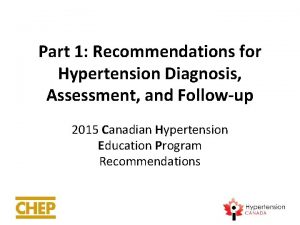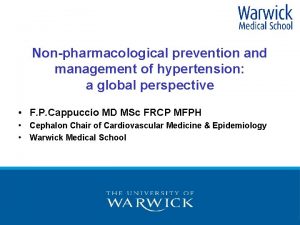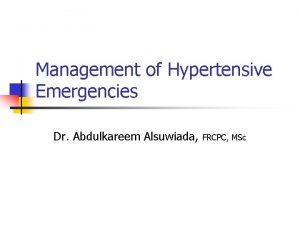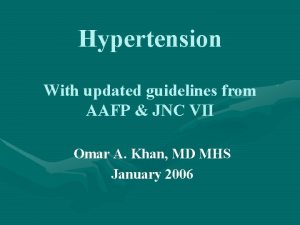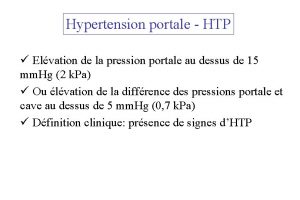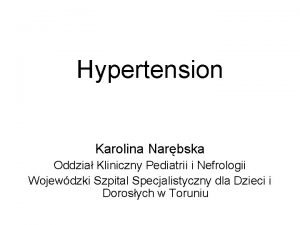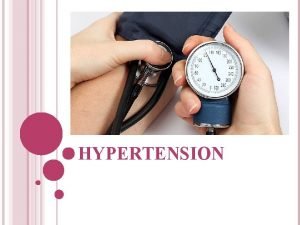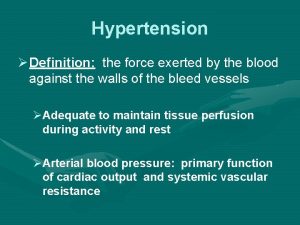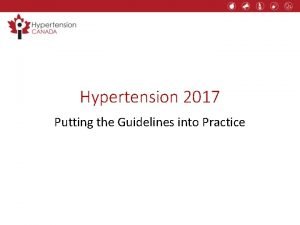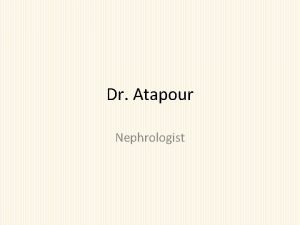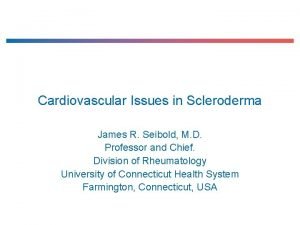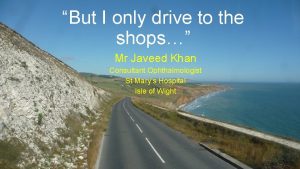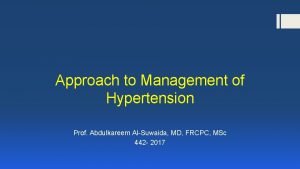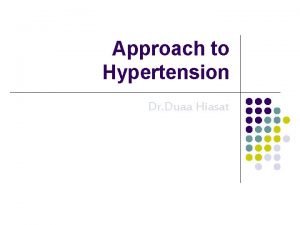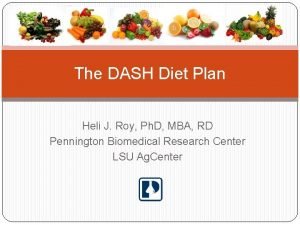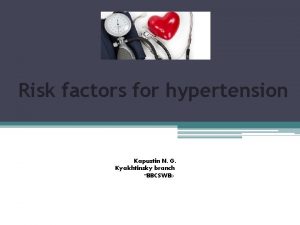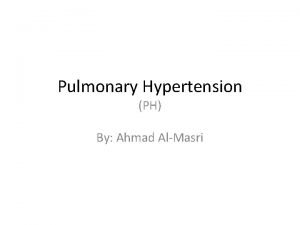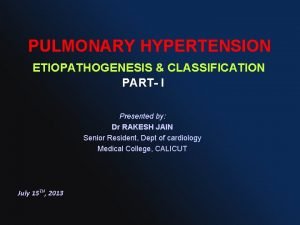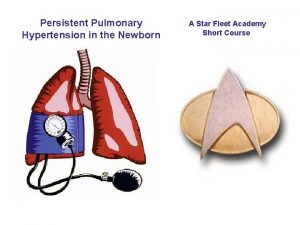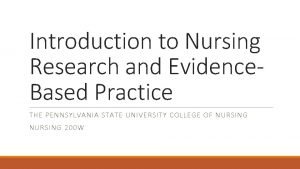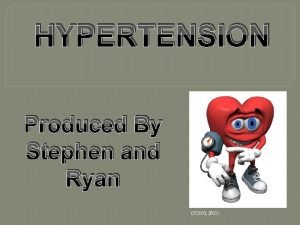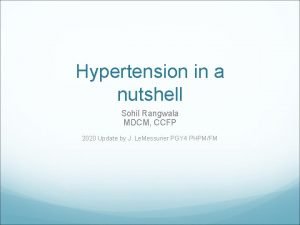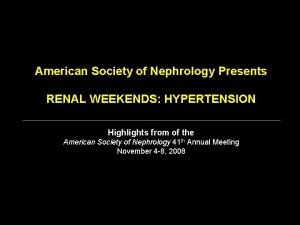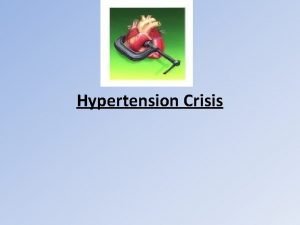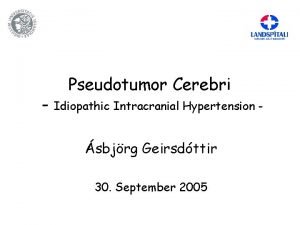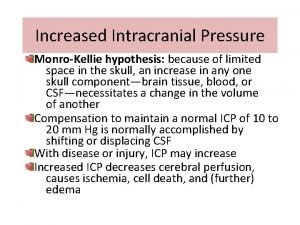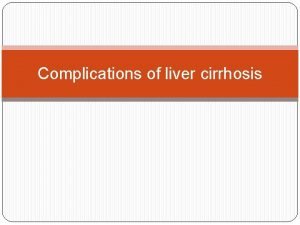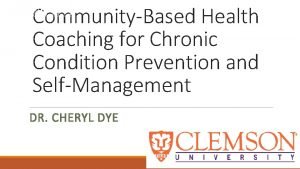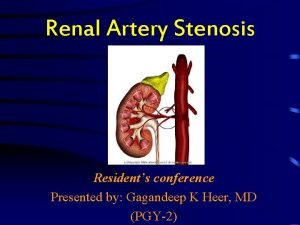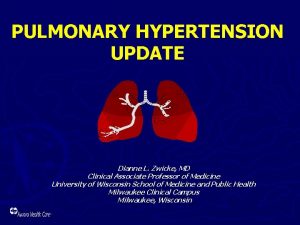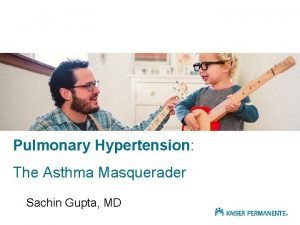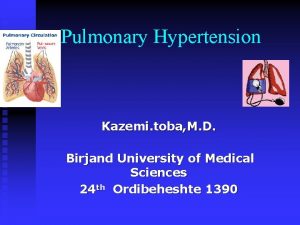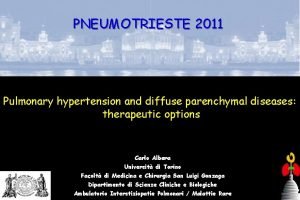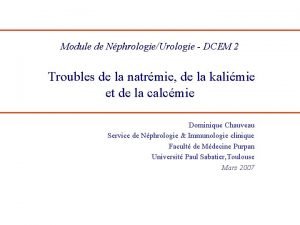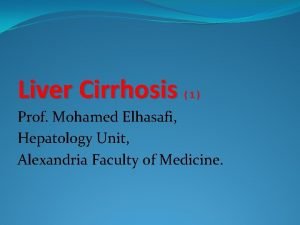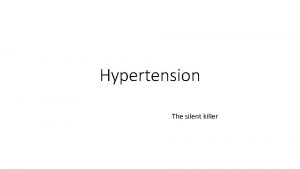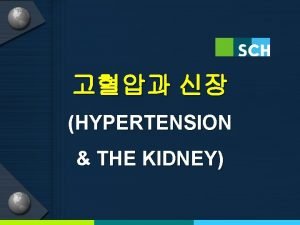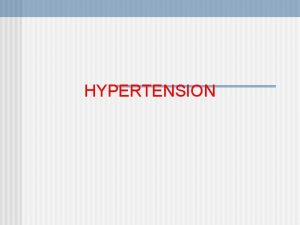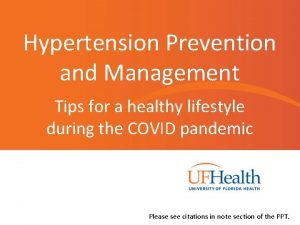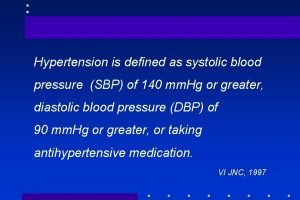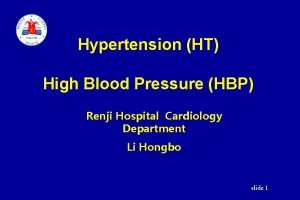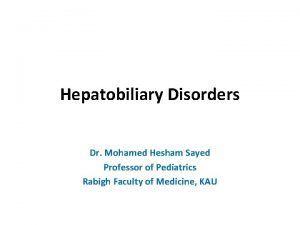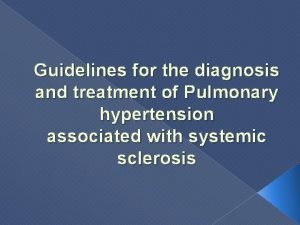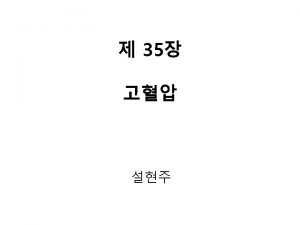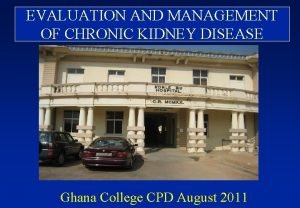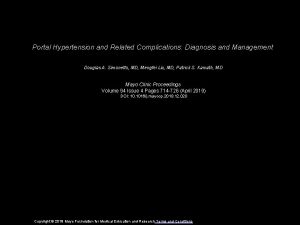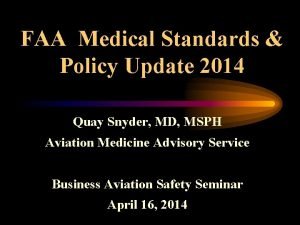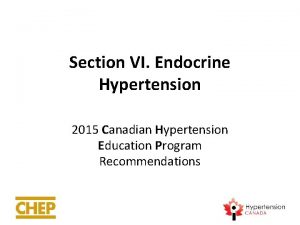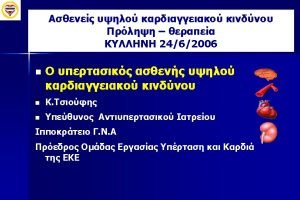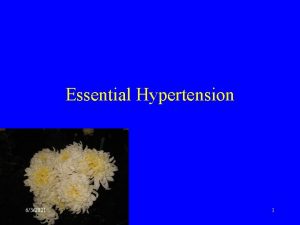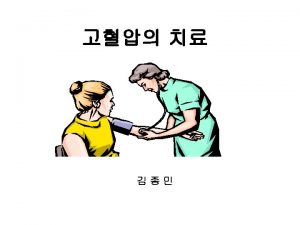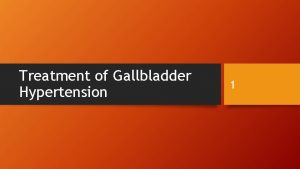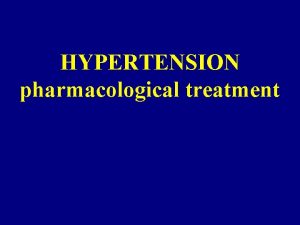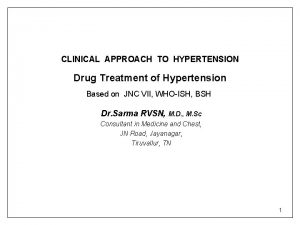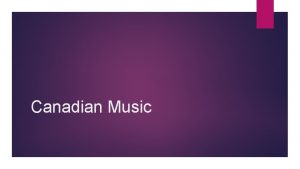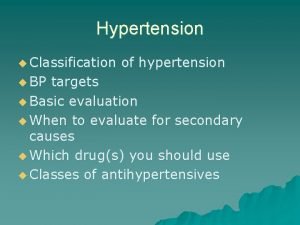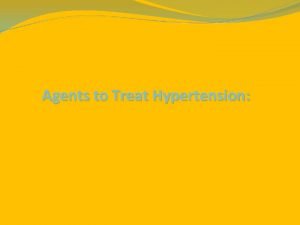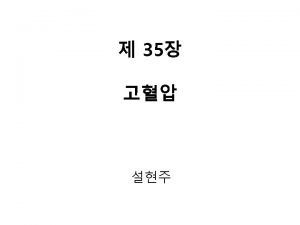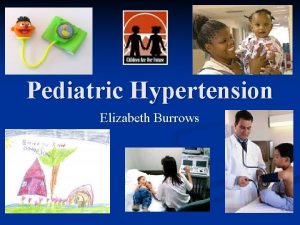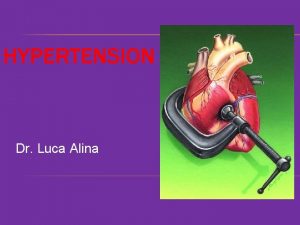Part 2 Recommendations for Hypertension Treatment 2015 Canadian


















































































- Slides: 82

Part 2: Recommendations for Hypertension Treatment 2015 Canadian Hypertension Education Program Recommendations

The full slide set of the 2015 CHEP Recommendations is available at www. hypertension. ca 2015

2015 Canadian Hypertension Education Program (CHEP) • A red flag has been posted where recommendations were updated for 2015. • Slide kits for health care professional and public education can be downloaded (English and French versions) from www. hypertension. ca 2015

CHEP Key Messages for the Management of Hypertension 1. 2. 3. 4. 5. 6. 7. 8. All Canadian adults should have their blood pressure assessed at all appropriate clinical visits. Electronic (oscillometric) measurement methods are preferred to manual measurement. Out-of-office measurement should be performed to confirm the initial diagnosis of hypertension. Optimum management of the hypertensive patient requires assessment and communication of overall cardiovascular risk using an analogy like ‘vascular age’. Home BP monitoring is an important tool in self-monitoring and self-management. Health behaviour modification is effective in preventing hypertension, treating hypertension and reducing cardiovascular risk. Combinations of both health behaviour changes and drugs are generally necessary to achieve target blood pressures. Focus on adherence. Treat to target. 2015

CHEP 2015 Recommendations What’s new? • Assess clinic blood pressures using electronic (oscillometric) monitors • The diagnosis of hypertension should be based on out-ofoffice measurements • The management of hypertension is all about global cardiovascular risk management and vascular protection including advice and treatment for smoking cessation • Treatment of atherosclerotic renal artery stenosis is primarily medical 2015

CHEP 2015 Recommendations What’s still important? • Know the BP threshold and treat to target • Adopting healthy behaviours is integral to the management of hypertension • The most important step in prescription of antihypertensive therapy is achieving patient “buy-in” 2015

2015 Canadian Hypertension Education Program (CHEP) Treatment Approaches: – Health Behaviours – Pharmacological 2015

Recommendations 2015 Table of contents I. III. IV. V. VIII. IX. X. XIII. XIV. Health behaviour management Indications for drug therapy Choice of therapy Global vascular protection Goal of therapy CV – IHD CHF Cerebrovascular / Stroke LVH Chronic kidney disease Renovascular Diabetes Adherence strategies for patients Endocrine 2015

I. Health Behaviour Management 2015 Canadian Hypertension Education Program Recommendations

Health Behaviour Recommendations to Reduce Blood Pressure • Reduce sodium intake towards 2000 mg/day • Healthy diet: high in fresh fruits, vegetables, low fat dairy products, dietary and soluble fibre, whole grains and protein from plant sources, low in saturated fat, cholesterol and salt in accordance with Canada's Guide to Healthy Eating. • Regular physical activity: accumulation of 30 -60 minutes of moderate intensity dynamic exercise 4 -7 days per week in addition to daily activities • Low risk alcohol consumption: (≤ 2 standard drinks/day and less than 14/week for men and less than 9/week for women) • Attaining and maintaining ideal body weight (BMI 18. 5 -24. 9 kg/m 2) • Waist Circumference: Men <102 cm Women <88 cm • Smoke free environment 2015

Health Behaviour Recommendations for Hypertension: Dietary Sodium High in: • Fresh fruits • Fresh vegetables • Low fat dairy products • Dietary and soluble fibre • Plant protein Low in: 2000 mg / day (Most of the salt in food is ‘hidden’ and comes from processed food) Dietary Potassium Daily dietary intake >80 mmol Calcium supplementation • Saturated fat and cholesterol • Sodium No conclusive studies for hypertension Magnesium supplementation No conclusive studies for hypertension www. hc-sc. gc. ca/fn-an/food-guide-aliment/index-eng. php. 2015

Potential Benefits of a Wide Spread Reduction in Dietary Sodium in Canada Reduction in average dietary sodium from about 3500 mg to 1700 mg 1, 2 • 1 million fewer hypertensives • 5 million fewer physicians visits a year for hypertension • Health care cost savings of $430 to 540 million per year related to fewer office visits, drugs and laboratory costs for hypertension • Improvement of the hypertension treatment and control rate • 13% reduction in CVD • Total health care cost savings of over $1. 3 billion/year 1. Penz ED. Cdn J Cardiol 2008 2. Joffres MR. Cdn J Cardiol 2007: 23(6) 2015

Recommendations for adequate daily sodium intake 2, 000 mg sodium (Na) = 87 mmol sodium (Na) = 5 g of salt (Na. Cl) ~1 teaspoon of table salt • 80% of average sodium intake is in processed foods • Only 10% is added at the table or in cooking Institute of Medicine, 2003 2015

Sodium: Meta-analyses Average Reduction of sodium in mg/day 1800 mg/day 2300 mg/day Hypertensives Reduction of BP 5. 1 / 2. 7 mm. Hg 7. 2/3. 8 mm. Hg Average Reduction of sodium in mg/day 1700 mg/day 2300 mg/day Normotensives Reduction of BP 2. 0 / 1. 0 mm. Hg 3. 6/1. 7 mm. Hg The Cochrane Library 2006; 3: 1 -41 2015

2015 Canadian Hypertension Education Program (CHEP) Important messages from past recommendations • High dietary sodium is estimated to increase blood pressure in the Canadian population to the extent that 1, 000 Canadians meet the diagnostic criteria for hypertension who would otherwise have ‘normal’ blood pressure • Most of the sodium in Canadian diets comes from processed foods and restaurants. • Pizza, breads, soups and sauces usually have high amounts of sodium • Patient information on how to achieve a reduced sodium diet can be found at www. hypertension. ca • Aim to reduce dietary sodium intake to prevent and control hypertension 2015

Health Behaviour Recommendations for Hypertension: Physical Activity Should be prescribed to reduce blood pressure F Frequency - Four to seven days per week I Intensity - Moderate T Time - 30 -60 minutes T Type Cardiorespiratory Activity - Walking, jogging - Cycling - Non-competitive swimming Exercise should be prescribed as an adjunctive to pharmacological therapy 2015

Health Behaviour Recommendations for Hypertension: Weight Loss Height, weight, and waist circumference (WC) should be measured and body mass index (BMI) calculated for all adults. Hypertensive and all patients BMI over 25 - Encourage weight reduction - Healthy BMI: 18. 5 -24. 9 kg/m 2 Waist Circumference Men <102 cm Women <88 cm For patients prescribed pharmacological therapy: weight loss has additional antihypertensive effects. Weight loss strategies should employ a multidisciplinary approach and include dietary education, increased physical activity and behaviour modification CMAJ 2007; 176: 1103 -6 2015

Waist Circumference Measurement Measure here Iliac crest Courtesy J. P. Després 2006 2015

Health Behaviour Recommendations for Hypertension: Alcohol Low risk alcohol consumption • 0 -2 standard drinks/day • Men: maximum of 14 standard drinks/week • Women: maximum of 9 standard drinks/week A standard drink is about 142 ml or 5 oz of wine (12% alcohol); 341 m. L or 12 oz of beer (5% alcohol); 43 m. L or 1. 5 oz of spirits (40% alcohol). 2015

Health Behaviour Recommendations for Hypertension: Stress Management Stress management Hypertensive patients in whom stress appears to be an important issue Behaviour Modification Individualized cognitive behavioural interventions are more likely to be effective when relaxation techniques are employed. 2015

Impact of health behaviour management on blood pressure Intervention Systolic BP (mm. Hg) Diastolic BP (mm. Hg) Diet and weight control -6. 0 -4. 8 Reduced salt/sodium intake - 5. 4 - 2. 8 Reduced alcohol intake (heavy drinkers) -3. 4 DASH diet -11. 4 -5. 5 Physical activity -3. 1 -1. 8 Relaxation therapies -5. 5 -3. 5 Clinical Guideline: Methods, evidence and recommendations National Institute for Health and Clinical Excellence (NICE) May 2011 2015

Health Behaviour Management: Summary Intervention Target Reduce foods with added sodium Weight loss → 2000 mg /day Alcohol restriction < 2 drinks/day Physical activity Dietary patterns 30 -60 minutes 4 -7 days/week DASH diet Smoking cessation Smoke free environment Waist circumference Men <102 cm BMI <25 kg/m 2 Women <88 cm 2015

Prevalence % Epidemiologic impact on mortality of blood pressure reduction in the population After Intervention Before Intervention Reduction in BP % Reduction in Mortality Reduction in SBP (mm. Hg) Stroke CHD Total 2 -6 -4 -3 3 -8 -5 -4 5 -14 -9 -7 Adapted from Whelton, PK et al. JAMA 2002; 288: 1882 -1888 2015

II. Indications for Pharmacotherapy 2015 Canadian Hypertension Education Program Recommendations

II. Indications for Pharmacotherapy Usual blood pressure threshold values for initiation of pharmacological treatment Population SBP > Diabetes 130 80 High risk (TOD or CV risk factors) 140 90 Low risk (no TOD or CV risk factors) Very elderly* (≥ 80 yrs. ) 160 100 160 NA TOD = target organ damage *This higher treatment target for the very elderly reflects current evidence and heightened concerns of precipitating adverse effects, particularly in frail patients. Decisions regarding initiating and intensifying pharmacotherapy in the very elderly should be based upon an individualized risk-benefit analysis. 2015

II. Indications for Pharmacotherapy Recommended Treatment Targets Treatment consists of health behaviour ±pharmacological management Population SBP < Diabetes 130 80 All others < 80 yrs. (including CKD) Very elderly (≥ 80 yrs. ) 140 90 150 NA In patients with coronary artery disease be cautious when lowering blood pressure if diastolic blood pressures are < 60 mm. Hg 2015

Additional Considerations after diagnosis of hypertension (1) • Patients at very low risk with stage 1 hypertension (140159/90 -99 mm. Hg) – Lifestyle modification can be the sole therapy • Many younger hypertensive Canadians with multiple cardiovascular risks are currently not treated with pharmacotherapy. Health care professionals need to be aware of this important care gap. 2015

III. Choice of Pharmacotherapy 2015 Canadian Hypertension Education Program Recommendations

III. Choice of Pharmacological Treatment Uncomplicated Associated risk factors? or Target organ damage/complications? or Concomitant diseases/conditions? NO Treatment in the absence of compelling indications for specific therapies YES Individualized Treatment (and compelling indications) 2015

III. Choice of Pharmacological Treatment 1. Treatment of Systolic/Diastolic hypertension without other compelling indications 2. Treatment of Isolated Systolic hypertension without other compelling indications 2015

III. Treatment of Adults with Systolic/Diastolic Hypertension without Other Compelling Indications TARGET <140/90 mm. Hg INITIAL TREATMENT AND MONOTHERAPY Health Behaviour Management Thiazide ACEI ARB Longacting CCB Betablocker* A combination of 2 first line drugs may be considered as initial therapy if the blood pressure is >20 mm. Hg systolic or >10 mm. Hg diastolic above target *BBs are not indicated as first line therapy for age 60 and above ACEI, ARB and direct renin inhibitors are contraindicated in pregnancy and caution is required in prescribing to women of child bearing potential 2015

III. Considerations Regarding the Choice of First-Line Therapy • Use caution in initiating therapy with 2 drugs in whom adverse events are more likely (e. g. frail elderly, those with postural hypotension or who are dehydrated). • ACE inhibitors, renin inhibitors and ARBs are contraindicated in pregnancy and caution is required in prescribing to women of child bearing potential. • Beta blockers are not recommended as first line therapy for patients age 60 and over without another compelling indication. • Diuretic-induced hypokalemia should be avoided through the use of potassium sparing agents if required. • The use of dual therapy with an ACE inhibitor and an ARB should only be considered in selected and closely monitored people with advanced heart failure or proteinuric nephropathy. • ACE-inhibitors are not recommended (as monotherapy) for black patients without another compelling indication. 2015

III. Add-on Therapy for Systolic/Diastolic Hypertension without Other Compelling Indications If partial response to monotherapy 1. Add-on Therapy 2. Triple or Quadruple Therapy IF BLOOD PRESSURE IS NOT CONTROLLED CONSIDER • Nonadherence • Secondary HTN • Interfering drugs or lifestyle • White coat effect If blood pressure is still not controlled, or there adverse effects, other classes of antihypertensive drugs may be combined (such as alpha blockers or centrally acting agents). 2015

Drug Combinations When combining drugs, use first-line therapies. • Two drug combinations of beta blockers, ACE inhibitors and angiotensin receptor blockers have not been proven to have additive hypotensive effects. Therefore these potential two drug combinations should not be used unless there is a compelling (non blood pressure lowering) indication • Combinations of an ACEI with an ARB do not reduce cardiovascular events more than the ACEI alone and have more adverse effects therefore are not generally recommended 2015

Drug Combinations cont’d • Caution should be exercised in combining a non dihydropyridine CCB and a beta blocker to reduce the risk of bradycardia or heart block. • Monitor serum creatinine and potassium when combining K sparing diuretics (such as aldosterone antagonists), ACE inhibitors and/or angiotensin receptor blockers. • If a diuretic is not used as first or second line therapy, triple therapy should include a diuretic, when not contraindicated. 2015

Medication Use and BP Control in ALLHAT % <140/90 mm Hg Cushman et al. J Clin Hypertens 2002; 4: 393 -404 2015

Incremenal SBP reduction ratio Observed/Expected (additive) Ratio of Incremental SBP lowering effect at “standard dose”– Combine or Double? Wald et al. Combination Versus Monotherapy for Blood Pressure Reduction, The American Journal of Medicine, Vol 122, No 3, March 2009 2015

BP lowering effects from antihypertensive drugs • Dose response curves for efficacy are relatively flat • 80% of the BP lowering efficacy is achieved at half-standard dose • Combinations of standard doses have additive blood pressure lowering effects Law. BMJ 2003 2015

III. Summary: Treatment of Systolic-Diastolic Hypertension without Other Compelling Indications TARGET <140/90 mm. Hg Health Behaviour Management Initial therapy Thiazide diuretic CONSIDER • Nonadherence • Secondary HTN • Interfering drugs or lifestyle • White coat effect ACEI ARB Long-acting CCB A combination of 2 first line drugs may be considered as initial therapy if the blood pressure is >20 mm. Hg systolic or >10 mm. Hg diastolic above target Betablocker* Dual Combination Triple or Quadruple Therapy *Not indicated as first line therapy over 60 y 2015

III. Treatment Algorithm for Isolated Systolic Hypertension without Other Compelling Indications TARGET <140 mm. Hg (< 150 mm. Hg if age > 80 years) INITIAL TREATMENT AND MONOTHERAPY Health Behaviour Management Thiazide diuretic ARB Long-acting DHP CCB 2015

III. Add-on therapy for Isolated Systolic Hypertension without Other Compelling Indications If partial response to monotherapy Dual combination Combine first line agents Thiazide diuretic ARB Long-acting DHP CCB CONSIDER • Nonadherence • Secondary HTN • Interfering drugs or lifestyle • White coat effect Triple therapy If blood pressure is still not controlled, or there adverse effects, other classes of antihypertensive drugs may be combined (such as ACE inhibitors, alpha adrenergic blockers, centrally acting agents, or nondihydropyridine calcium channel blocker). 2015

III. Summary: Treatment of Isolated Systolic Hypertension without Other Compelling Indications TARGET <140 mm. Hg, < 150 mm. Hg for age > 80 years Health Behaviour Management Thiazide diuretic ARB CONSIDER Dual therapy • Nonadherence • Secondary HTN • Interfering drugs or lifestyle • White coat effect Triple therapy Long-acting DHP CCB *If blood pressure is still not controlled, or there adverse effects, other classes of antihypertensive drugs may be combined (such as ACE inhibitors, alpha blockers, centrally acting agents, or nondihydropyridine calcium channel blocker). 2015

Choice of Pharmacological Treatment for Hypertension Individualized treatment • Compelling indications: – – – – • Ischemic Heart Disease Recent ST Segment Elevation-MI or non-ST Segment Elevation-MI Left Ventricular Systolic Dysfunction Cerebrovascular Disease Left Ventricular Hypertrophy Non Diabetic Chronic Kidney Disease Renovascular Disease Smoking Diabetes Mellitus – With Nephropathy – Without Nephropathy • Global Vascular Protection for Hypertensive Patients – Statins if 3 or more additional cardiovascular risks – Aspirin once blood pressure is controlled 2015

IV. Global Vascular Protection for Adults with Hypertension 2015 Canadian Hypertension Education Program Recommendations

IV. Vascular Protection for Hypertensive Patients: Statins In addition to current Canadian recommendations on management of dyslipidemia, statins are recommended in high-risk hypertensive patients with established atherosclerotic disease or with at least 3 of the following criteria: • Male • Age 55 or older • Smoking • Total-C/HDL-C ratio of 6 mmol/L or higher • Family History of Premature CV disease • LVH • ECG abnormalities • Microalbuminuria or Proteinuria ASCOT-LLA Lancet 2003; 361: 1149 -58 2015

IV. Vascular Protection for Hypertensive Patients: ASA Low dose ASA in hypertensive patients >50 years Caution should be exercised if BP is not controlled. Hansson L, Zanchetti A, Carruthers SG, et al. Effects of intensive blood-pressure lowering and low-dose aspirin in patients with hypertension: principal results of the Hypertension Optimal Treatment (HOT) randomised trial. Lancet 1998; 351: 1755 -1762. 2015

New 2015 Recommendation: Vascular Protection Tobacco use status of all patients should be updated on a regular basis and health care providers should clearly advise patients to quit smoking. 2015

Effect of advice on smoking cessation rates Cochrane Database Syst Rev. 2013 May 31; 5: CD 000165. doi: 10. 1002/14651858. CD 000165. pub 4 2015

New 2015 Recommendation: Vascular Protection Advice in combination with pharmacotherapy (e. g. , varenicline, bupropion, nicotine replacement therapy) should be offered to all smokers with a goal of smoking cessation. 2015

Cochrane network meta-analysis 2014 Kate Cahill et al • Nicotine replacement therapy, antidepressant bupropion, and nicotine receptor partial agonist varenicline (Champix) • Impact on long term abstinence- 6 months or longer • Synthesis of 12 Cochrane reviews – 267 studies – Over 10, 000 participants 2015

Network meta-analysis of smoking cessation pharmacotherapies studies NRT vs. Placebo 1. 84 (1. 71, 1. 99) Buproprion vs. Placebo 1. 82 (1. 6, 2. 06) Varenicline vs. Placebo 2. 88 (2. 4, 3. 47) Buproprion vs. NRT 0. 99 (0. 86, 1. 13) Varenicline vs. NRT 1. 57 (1. 29, 1. 91) Varenicline vs. Buproprion 1. 59 (1. 29, 1. 96) Cochrane Database Syst Rev. 2013 May 31; 5: CD 000165. 2015 doi: 10. 1002/14651858. CD 000165. pub 4

V. Goals of Therapy 2015 Canadian Hypertension Education Program Recommendations

V. Goals of Therapy Blood pressure target values for treatment of hypertension Condition Target SBP and DBP mm. Hg Isolated systolic hypertension Age > 80 years <140 < 150 Systolic/Diastolic Hypertension • Systolic BP • Diastolic BP <140 <90 Diabetes • Systolic • Diastolic <130 <80 2015

Follow-up of blood pressure above targets • Patients with blood pressure above target are recommended to be followed at least every 2 nd month • Follow-up visits are used to increase the intensity of health behaviour modification and drug therapy, monitor the response to therapy and assess adherence 2015

VI. Treatment of Hypertension in Patients with Ischemic Heart Disease Stable angina 1. Beta-blocker 2. Long-acting CCB ACEI are recommended for most patients with established CAD* ARBs are not inferior to ACEI in IHD • Caution should be exercised when combining a non DHP-CCB and a beta-blocker • If abnormal systolic left ventricular function: avoid non DHP-CCB (Verapamil or Diltiazem) • Dual therapy with an ACEI and an ARB are not recommended in the absence of refractory heart failure • The combination of an ACEi and CCB is preferred *Those at low risk with well controlled risk factors may not benefit from ACEI therapy Short-acting nifedipine 2015

VI. Treatment of Hypertension in Patients with Recent ST Segment Elevation-MI or non-ST Segment Elevation-MI Recent myocardial infarction Beta-blocker and ACEI or ARB If beta-blocker contraindicated or not effective Heart Failure? YES Long-acting Dihydropyridine CCB* NO Long-acting CCB *Avoid non dihydropyridine CCBs (diltiazem, verapamil) 2015

VII. Treatment of Hypertension with Left Ventricular Systolic Dysfunction Systolic cardiac dysfunction • ACEI and Beta blocker • if ACEI intolerant: ARB Titrate doses of ACEI or ARB to those used in clinical trials If additional therapy is needed: • Diuretic (Thiazide for hypertension; Loop for volume control) • for CHF class II-IV or post MI and selected patients with LV dysfunction (see notes): Aldosterone Antagonist If ACEI and ARB are contraindicated: Hydralazine and Isosorbide dinitrate in combination Non dihydropyridine CCB If additional antihypertensive therapy is needed: • ACEI / ARB Combination • Long-acting DHP-CCB (Amlodipine) Beta-blockers used in clinical trials were bisoprolol, carvedilol and metoprolol. 2015

VIII. Treatment of Hypertension in Association With Stroke Acute Stroke: Onset to 72 Hours Acute ischemic Stroke Treat extreme BP elevation (systolic > 220 mm. Hg, diastolic > 120 mm. Hg) by 1525% over the first 24 hour with gradual reduction after. • If eligible for thrombolytic therapy treat very high BP (>185/110 mm. Hg) Avoid excessive lowering of BP which can exacerbate ischemia 2015

VIII. Treatment of Hypertension in Association With Stroke Acute Stroke: Onset to 72 Hours Strongly consider blood pressure reduction in all patients after the acute phase of stroke or TIA. Stroke TIA Target BP < 140/90 mm. Hg An ACEI / diuretic combination is preferred Combinations of an ACEI with an ARB are not recommended 2015

IX. Treatment of Hypertension in Patients with Left Ventricular Hypertrophy Hypertensive patients with left ventricular hypertrophy should be treated with antihypertensive therapy to lower the rate of subsequent cardiovascular events Left ventricular hypertrophy - ACEI - ARB - CCB - Thiazide Diuretic - BB (if age below 60) Vasodilators: Hydralazine, Minoxidil can increase LVH 2015

X. Treatment of Hypertension in Patients with Non Diabetic Chronic Kidney Disease Target BP: < 140/90 mm. Hg Chronic kidney disease and proteinuria * ACEI or ARB (if ACEI intolerant) Additive therapy: Thiazide diuretic. Alternate: If volume overload: loop diuretic Combination with other agents * albumin: creatinine ratio [ACR] > 30 mg/mmol or urinary protein > 500 mg/24 hr ACEI/ARB: Bilateral renal artery stenosis Monitor serum potassium and creatinine carefully in patients with CKD prescribed an ACEI or ARB Combinations of a ACEI and a ARB are specifically not recommended in the absence of proteinuria 2015

New 2015 Recommendation: Renovascular Patients with hypertension attributable to atherosclerotic renal artery stenosis (RAS) should be primarily medically managed because renal angioplasty and stenting offers no benefit over optimal medical therapy alone. 2015

CORAL: Cooper et al, Stenting & Medical Rx for Atherosclerotic RAS 947 Patients: -HT with SBP≥ 155 while on ≥ 2 drugs; OR -CKD: GFR <60 m. L/min/1. 73 m 2 AND -RAS ≥ 80% or ≥ 60% with SBP gradient ≥ 20 mm. Hg Intervention (1: 1): -Palmaz Genesis stent (Cordis) Concurrent Medical Rx: -antiplatelet; -Anti-HT to <140/90 (DM: 130/80) with candesartan, HCT, amlodipine; -lipid Rx (atorvastatin); glucose Primary Outcome: -Composite: Death (CV/renal), stroke, MI, stroke, HFhosp, prog renal insuff, perm RRT NEJM 2014; 370; 13 -22. 2015

New 2015 Recommendation: Renovascular Renal artery angioplasty and stenting for atherosclerotic hemodynamically significant renal artery stenosis should be considered for patients with uncontrolled hypertension resistant to maximally tolerated pharmacotherapy, progressive renal function loss, and acute pulmonary edema. 2015

Why RCTs might not define best care for some RVHT/RAS patients: low inclusion thresholds RCT CORAL Inclusion Criteria Enrolled Subjects BP #AHT % stenosis S≥ 155 ≥ 2 drugs ≥ 60/80% 150 2. 1 drugs 67% ≥ 70% 149 -152 2. 8 drugs 75% ASTRAL STAR “Controlled BP” ≥ 50% 160 -163 2. 8 -2. 9 70 -90% DRASTIC D≥ 95 ≥ 2 drugs ≥ 50% 179 -180 2. 0 72 -76% SNRASCG D≥ 95 ≥ 2 drugs ≥ 50% 182 -190 EMMA D≥ 95 Yes ≥ 60/75% 158 -165 1. 33 DDD <75% 2015

XI. Treatment of Hypertension in Patients with Atherosclerotic Renovascular Disease Atherosclerotic renovascular disease Primarily medically managed Caution in the use of ACEI or ARB in bilateral renal artery stenosis or unilateral disease with solitary kidney Patients with hypertension attributable to atherosclerotic renal artery stenosis (RAS) should be primarily medically managed because renal angioplasty and stenting offers no benefit over optimal medical therapy alone (Grade B). 2015

XII. Treatment of Hypertension in Association with Diabetes Mellitus 2015 Canadian Hypertension Education Program Recommendations

XII. Treatment of Hypertension in association with Diabetes Mellitus Threshold equal or over 130/80 mm. Hg and Target below 130/80 mm. Hg with Nephropathy* *Urinary albumin to creatinine ratio > 2. 0 mg/mmol in men or > 2. 8 mg/mmol in women* Diabetes without Nephropathy** Systolicdiastolic Hypertension Isolated Systolic Hypertension A combination of 2 first line drugs may be considered as initial therapy if the blood pressure is >20 mm. Hg systolic or >10 mm. Hg diastolic above target Combinations of an ACEI with an ARB are specifically not recommended in the absence of proteinuria * based on at least 2 of 3 measurements Rabi DM, et al. CMAJ. 2013; 185(11): 963 -967. 2015

XII. Treatment of Hypertension in association with Diabetic Nephropathy THRESHOLD equal or over 130/80 mm. Hg and TARGET below 130/80 mm. Hg DIABETES with Nephropathy ACE Inhibitor or ARB Addition of one or more of Long-acting CCB or Thiazide diuretic IF ACEI and ARB are contraindicated or not tolerated, SUBSTITUTE • Long-acting CCB or • Thiazide diuretic 3 - 4 drugs combination may be needed If Creatinine over 150 µmol/L or creatinine clearance below 30 ml/min ( 0. 5 ml/sec), a loop diuretic should be substituted for a thiazide diuretic if control of volume is desired Monitor serum potassium and creatinine carefully in patients with CKD prescribed an ACEI or ARB 2015

2015 Canadian Hypertension Education Program (CHEP) Important messages from past recommendations • Patients with diabetes are at high cardiovascular risk • Most patients with diabetes have hypertension • Treatment of hypertension in patients with diabetes reduces total mortality, myocardial infarction, stroke, retinopathy and progressive renal failure rates. • Treating hypertension in patients with diabetes reduces death and disability and reduces health care system costs • In diabetes, TARGET <130 systolic and <80 mm. Hg diastolic • If a patient has both diabetes and CKD, TARGET <130 systolic and <80 mm. Hg diastolic • The use of the combination of ACE inhibitor with an ARB should only be considered in selected and closely monitored people with advanced heart failure or proteinuric nephropathy. 2015

XII. Treatment of Systolic-Diastolic Hypertension without Diabetic Nephropathy Threshold equal or over 130/80 mm. Hg and TARGET below 130/80 mm. Hg Diabetes without Nephropathy DHP: dihydropyridine 1. ACE Inhibitor or ARB or 2. Dihydropyridine CCB or Thiazide diuretic IF ACE Inhibitor and ARB and DHP-CCB and Thiazide are contraindicated or not tolerated, SUBSTITUTE • Cardioselective BB* or • Long-acting NON DHP-CCB Combination of first line agents Addition of one or more of: Cardioselective BB or Long-acting CCB Combinations of an ACE Inhibitor with an ARB are specifically not recommended in the absence of proteinuria * Cardioselective BB: Acebutolol, Atenolol, Bisoprolol , Metoprolol More than 3 drugs may be needed to reach target values for diabetic patients 2015

ACCORD Study: Results and rationale for lack of impact on BP recommendations • Overall BP study was neutral with no benefit of systolic target < 120 mm. Hg vs < 140 mm. Hg for primary outcome, yet: • Power issue: Annual rate of primary outcome 1. 87% in the intensive arm versus 2. 09% in the standard arm vs 4%/year event rate projected during sample size calculations • Significant interaction between BP and glycaemia control studies such that those in usual care glycaemia group (A 1 c 7%+) had a significant improvement in primary outcome with lower BP target • Secondary outcome for stroke reduction showed a benefit for lower BP target (41% RRR) • Therefore no clear evidence supporting a change in BP targets for people with diabetes at this point ACCORD study NEJM 2010 2015

XII. Treatment of Hypertension in association with Diabetes Mellitus: Summary Threshold equal or over 130/80 mm. Hg and TARGET below 130/80 mm. Hg ACE Inhibitor or ARB Diabetes without Nephropathy 1. ACE Inhibitor or ARB or 2. DHP-CCB or Thiazide diuretic A combination of 2 first line drugs may be considered as initial therapy if the blood pressure is >20 mm. Hg systolic or >10 mm. Hg diastolic above target. Combining an ACEi and a DHP-CCB is recommended. > 2 -drug combinations Monitor serum potassium and creatinine carefully in patients with CKD prescribed an ACEI or ARB Combinations of an ACEI with an ARB are specifically not recommended in the absence of proteinuria More than 3 drugs may be needed to reach target values for diabetic patients If Creatinine over 150 µmol/L or creatinine clearance below 30 ml/min ( 0. 5 ml/sec), a loop diuretic should be substituted for a thiazide diuretic if control of volume is desired 2015

XIII. Adherence 2015 Canadian Hypertension Education Program Recommendations

XIII. Adherence to antihypertensive management can be improved by a multi-pronged approach • Assess adherence to pharmacological and health behaviour therapies at every visit • Teach patients to take their pills on a regular schedule associated with a routine daily activity e. g. brushing teeth. • Simplify medication regimens using long-acting once-daily dosing • Utilize single pill combination • Utilize unit-of-use packaging e. g. blister packaging 2015

XIII. Adherence to antihypertensive management can be improved by a multi-pronged approach • Encourage greater patient responsibility/autonomy in regular monitoring of their blood pressure • Educate patients and patients' families about their disease/treatment regimens verbally and in writing • Use an interdisciplinary care approach coordinating with work -site health care givers and pharmacists if available • Encouraging adherence to therapy by healthcare practitionerbased telephone contact, particularly, over the first three months of therapy 2015

Hypertension Patient Resources Online • www. hypertension. ca - Download current resources for the prevention and control of hypertension • www. hypertension. ca - Have your patients sign up to access the latest hypertension resources • www. c-changeprogram. ca -To learn more about the harmonized recommendations for CVD prevention and treatment • www. heartandstroke. ca/BP -To monitor home blood pressure and encourage self management of lifestyle • http: //www. hypertension. qc. ca/ - Société Québécoise d’hypertension artérielle 2015

Sodium Slide Kit • Tool used to educate the public and patients on dietary sodium. Download at www. hypertension. ca 2015

Brief Hypertension Action Tool Can by used by a healthcare provider to better inform and engage a hypertensive patient to ultimately become more active in their care. Involves 3 Action Tools: Action Tool # 1 – Explains High BP Action Tool # 2 – Self-management of lifestyle Action Tool # 3 – Proper home measurement & information about medication Download at www. hypertension. ca 2015

Measuring Blood Pressure The Right Way – Poster • Posters and pocket cards can be ordered from our website. • Brief highlights: 1. Preparing to taking your blood pressure 2. Using endorsed BP devices. 2015

CHEP Key Messages for the Management of Hypertension 1. 2. 3. 4. 5. 6. 7. 8. All Canadian adults should have their blood pressure assessed at all appropriate clinical visits. Electronic (oscillometric) measurement methods are preferred to manual measurement. Out-of-office measurement should be performed to confirm the initial diagnosis of hypertension. Optimum management of the hypertensive patient requires assessment and communication of overall cardiovascular risk using an analogy like ‘vascular age’. Home BP monitoring is an important tool in self-monitoring and self-management. Health behaviour modification is effective in preventing hypertension, treating hypertension and reducing cardiovascular risk. Combinations of both health behaviour changes and drugs are generally necessary to achieve target blood pressures. Focus on adherence. Treat to target. 2015

hypertension. ca • For patients: • free access to the latest information and resources • For professionals: • Access an accredited 15. 5 hour interdisciplinary training program • Sign up for free monthly news updates, featured research and educational resources • Become a member for special privileges and savings 2015
 Hypokalemia
Hypokalemia Malignant hypertension treatment
Malignant hypertension treatment Hypertension artérielle
Hypertension artérielle Vital signs cpr
Vital signs cpr Hypertension
Hypertension Disease state awareness
Disease state awareness Syndrome méningé
Syndrome méningé Pah vs pulmonary hypertension
Pah vs pulmonary hypertension Hypertension
Hypertension Equivalence hbpm
Equivalence hbpm Hypertension
Hypertension Hypertensive urgency vs emergency
Hypertensive urgency vs emergency Demadex
Demadex Varices cardio-tubérositaires
Varices cardio-tubérositaires Non pharmacological management of hypertension
Non pharmacological management of hypertension Modifiable risk factors for hypertension
Modifiable risk factors for hypertension Bp = co x svr
Bp = co x svr Definition of hypertension
Definition of hypertension Masked hypertension
Masked hypertension Pulmonary hypertension severity
Pulmonary hypertension severity Causes of secondary hypertension
Causes of secondary hypertension Chronic liver stigmata
Chronic liver stigmata Hypertension vs hypotension
Hypertension vs hypotension Pulmonary hypertension differential diagnosis
Pulmonary hypertension differential diagnosis Signs of portal hypertension
Signs of portal hypertension Esterman efficiency score driving
Esterman efficiency score driving Htn emergency vs urgency
Htn emergency vs urgency Cataractectomy
Cataractectomy Veretigo
Veretigo Conclusion of hypertension
Conclusion of hypertension Aobp vs obpm
Aobp vs obpm Conclusion of hypertension
Conclusion of hypertension Pulmonary hypertension definition
Pulmonary hypertension definition Pah groups
Pah groups Mitral stenosis pulmonary hypertension
Mitral stenosis pulmonary hypertension What is a good pico question
What is a good pico question Conclusion of hypertension
Conclusion of hypertension Diagnosing hypertension
Diagnosing hypertension Presenting complaints of hypertension
Presenting complaints of hypertension Conclusion of hypertension
Conclusion of hypertension Medical nutrition therapy for hypertension
Medical nutrition therapy for hypertension Case scenario for hypertension
Case scenario for hypertension Fibrin cuff theory
Fibrin cuff theory Intracranial hypertension
Intracranial hypertension Nursing management of portal hypertension
Nursing management of portal hypertension Decerebrate posturing
Decerebrate posturing Complications of cirrhosis
Complications of cirrhosis Health coaches for hypertension control
Health coaches for hypertension control Rules of halves in hypertension
Rules of halves in hypertension Hypertension urgency vs emergency
Hypertension urgency vs emergency Pulmonary hypertension
Pulmonary hypertension Chd pulmonary hypertension
Chd pulmonary hypertension Hypertension
Hypertension Pneumotrieste
Pneumotrieste Isolated systolic hypertension
Isolated systolic hypertension Hyperkaliémie cause
Hyperkaliémie cause Stages of pulmonary hypertension
Stages of pulmonary hypertension Presinusoidal portal hypertension
Presinusoidal portal hypertension Jnc 8 classification of hypertension
Jnc 8 classification of hypertension Classification of hypertension
Classification of hypertension Hypertension
Hypertension Malignant hypertension ppt
Malignant hypertension ppt Jnc 8
Jnc 8 Hypertension drugs
Hypertension drugs Hypertensive urgency vs emergency
Hypertensive urgency vs emergency Neurotomas
Neurotomas Hypertension investigation chart
Hypertension investigation chart Portal hypertension definition
Portal hypertension definition Pulmonary hypertension
Pulmonary hypertension Diagnosis hypertension
Diagnosis hypertension Conclusion of hypertension
Conclusion of hypertension Pathophysiology of pulmonary hypertension
Pathophysiology of pulmonary hypertension Portal hypertension mayo clinic
Portal hypertension mayo clinic Aviation medicine advisory service
Aviation medicine advisory service Iso 22301 utbildning
Iso 22301 utbildning Typiska drag för en novell
Typiska drag för en novell Tack för att ni lyssnade bild
Tack för att ni lyssnade bild Vad står k.r.å.k.a.n för
Vad står k.r.å.k.a.n för Shingelfrisyren
Shingelfrisyren En lathund för arbete med kontinuitetshantering
En lathund för arbete med kontinuitetshantering Kassaregister ideell förening
Kassaregister ideell förening Personlig tidbok
Personlig tidbok Anatomi organ reproduksi
Anatomi organ reproduksi
